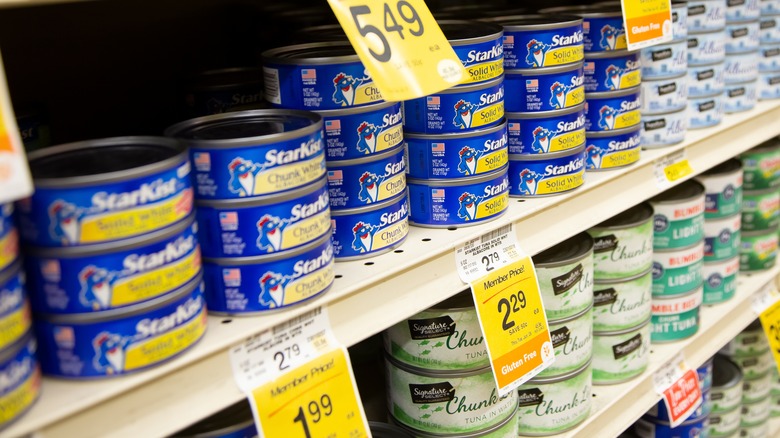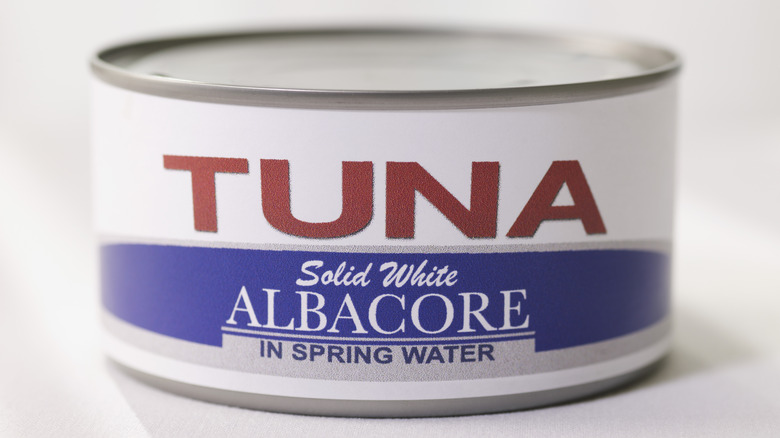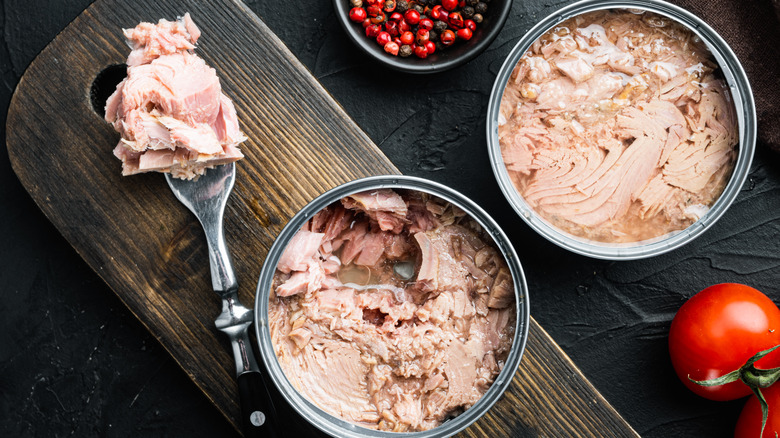The Differences Between White And Light Canned Tuna
Standing in the tin aisle of the store and staring into the abyss of canned tuna varieties is a daunting prospect. Which one do you need, and aren't they all the same? There are many differences to note about varieties of canned tuna, whether those are in texture, taste, what the tuna is stored in, or the size of the fish chunks. A subtle difference you may not yet have pondered is that between white and light canned tuna. It's understated but essential if you're serious about canned tuna.
White canned tuna is made from Albacore tuna, which has white or lighter-colored flesh. On the other hand, light tuna has a darker, pinker color than white tuna and is usually sourced from one or both of the tuna species skipjack and yellowfin. In terms of taste, white tuna is generally milder while light tuna tends to have a richer flavor. If you want your canned tuna recipes to shine, it's best to understand the exact differences between white and light tuna. With this knowledge, the canned tuna aisle will be a breeze.
White tuna to the core
White tuna, also named Thunnus alalunga, is almost always made from 100% albacore. Albacore is a slightly smaller tuna species that usually grows to 4 ½ feet and weighs up to 125 pounds. White canned tuna tends to be somewhat higher in fat than the lighter canned variety, which also means it has more Omega-3 fatty acids. It also tends to be firmer than the lighter canned variety, boasting a meaty texture similar to steak. Part of its firmness comes from the fact that large parts of the fish can be canned without being trimmed down, which is what you get if you choose solid white canned tuna. However, the chunky variety refers to tuna that has been broken down into smaller pieces.
White canned tuna's milder taste is best for dishes where you want other flavors to shine. Think fresh salads or wonton cups filled with a tuna filling and zingy dressing. However, its firmer texture would also make it ideal for fish tacos or dishes where you want big pieces of tuna to keep their shape.
The light canned variety
If you compare a can of light and white tuna, one of the immediately noticeable differences is the color and texture. Alongside its darker color, light canned tuna is almost always served in chunks, and this is due to the size differences between skipjack and yellowfin tuna. Skipjacks are fairly small, generally measuring around three feet and 70 pounds, while yellowfin are over double the length and weigh around 400 pounds. For the pieces in the can to be consistent, the bigger fish is cut down to match the smaller ones. This is one of the reasons you do not get solid light tuna.
Unlike white tuna, light tuna also tends to be softer with a moist texture. After draining a can, you'll see the tuna pieces still retain a little liquid. With this texture and strong fishy flavor, light canned tuna is incredible in sandwiches, casseroles, and stews — any dish where you want the fish to blend into a sauce.
It's also important to note that tuna brands can offer variations in the textures and flavors of their white and light tuna products. In other words, their taste may be influenced by olive oil or brine, and their texture could be impacted by how the fish was caught (net or line). Regardless, with the differences between white and light explained, the canned tuna aisle should be much easier to navigate.


